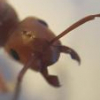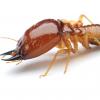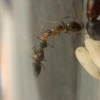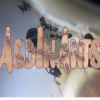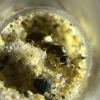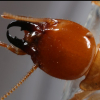What are Subterranean Termites?
Subterranean termites include most if not all species from the taxonomical family Rhinotermitidae, as well as, for the sake of keeping termites, select species from the family Termitidae. Essentially, in the context of keeping termites, subterranean termites include any species that nest in soil, and feed off of cellulose in contact with soil. So, although some species that will be mentioned are not taxonomically subterranean termites, they can be kept in a similar fashion, and so will be included in this guide.
Some well known species of subterranean termites include Reticulitermes flavipes, the Eastern Subterranean Termite, and Coptotermes formosanus, the Formosan Subterranean Termite. Subterranean termites can be found almost worldwide. If there are termites in your area, there’s a good chance that there are subterranean termites.
Safety and Containment
It may seem like a risky hobby, but termite keeping is pretty safe – for yourself, and for your home. There are no termites that sting. With subterranean termites, the worst you might get is a nip from a soldier, though that’s unlikely to break skin.
For those worried about your termites escaping, it should be noted that subterranean termites, and in fact most termite species, lack “sticky feet”, meaning they are incapable of climbing smooth surfaces such as glass or acrylic. If you’re keeping them in Tupperware of some sort, you need not worry about them crawling out – although for peace of mind, a barrier such as Fluon won’t hurt.
Should your subterranean termites escape, the chances that they’ll infest your home are small – it’s likely that they’ll dry out before they make any progress. Soil, particularly damp soil or substrate of some sort is essential for their survival. The lack of this in a home should prevent them from being a problem.
Distribution of Subterranean Termites
As mentioned previously, subterranean termites enjoy a large range. From America to Africa to Australia, subterranean termites have inhabited every continent. If there are termites in your area, there are likely subterranean termites as well.
Species of the genus Reticulitermes can be found all throughout the continental United States, Southern parts of Canada, and parts of Southern Europe. There are also species of Reticulitermes in Asia, and undoubtedly in Central and South America.
The genus Coptotermes, very similar to Reticulitermes, specifically the species Coptotermes formosanus, is extremely wide spread, mainly due to human commerce. Native to Southern China, Coptotermes formosanus can now be found in the southern United States, as well as Taiwan, Japan, much of Southeast Asia, and even parts of Africa, including South Africa.
For those in Australia, a few species of the genus Nasutitermes can occasionally be found in subterranean habitats. I’m not an expert on international subterranean termite species – there are many more that have not been mentioned that are subterranean, and probably live in many of the areas that I have not mentioned.
To find if your species can be kept like a subterranean termite, simply have it ID’d. If it’s in the taxonomical family of Rhinotermitidae, it can most likely be kept as described in this guide.
Micro Distribution
Subterranean termites nest in soil. For all practical purposes, accessing their soil nest is impossible without significantly damaging it. However, subterranean termites feed off of wood in contact with soil. When they feed, significant numbers of termites move into the wood, and will stay there whilst it is being consumed. In the interest of keeping termites, it is these that you want to find.
In my experience, subterranean termites have been in wood that is resting on damp soil, near a stream. I found mine in older growth forest – there was not significant plant growth on the forest floor. The species of subterranean termite that I keep, Reticulitermes flavipes, preferred hard wood that was not extremely decayed – you would struggle to peel off the bark.
Of course, subterranean termites may also be found in the home, though collecting these may be more troublesome, as it would require the removal of walls. And if you have termites infesting your home, you’re probably not too keen on keeping them.
Finding Subterranean Termites
Before I continue, it should be mentioned that, unlike ants, in order to start a colony (or intrusion if you wish to use proper terminology) of subterranean termites, you need not collect a mated pair of winged termites. Worker termites, given enough time away from their colony, will molt into reproductive forms and begin laying fertile eggs. Thus, in some respects, it is easy to start a subterranean termite colony, as you need only find workers – which constitute up to 90% or more of the colony’s population.
It should also be noted that every situation is different. If I find termites in one habitat in my area, they may not be in the exact same habitat in another area. They may be easier to find, or more difficult. It really takes time, and patience. As I’ve noted, it’s all about flipping the right logs and a fair bit of luck.
A good sign that subterranean termites inhabit a body of wood is that, when you flip the wood, there are a few termites below it. As mentioned before, subterranean termites don’t actually live in the wood, they live in the soil, and so there is always some traffic between the two bodies.
Now, termites are extremely talented at hiding and keeping a low profile. The termites you uncover when you flip a log will quickly disappear into the soil, so grab them whilst you can. I find that the easiest way to collect termites is with a wet paintbrush. They have delicate exoskeletons, and so one should aspire to be careful when dabbing them up.
Once you’ve determined that there are in fact termites in a log, you’ll want to break into that log. Using a saw, a screwdriver, or whatever other item you may think to bring, simply work away at the log. Termites will inhabit all of the log given the chance – they won’t hide right below the bark. When excavating, you may encounter chunks of wood – be sure to work away at these too – they can contain a surprising number of termites (again, they’re really good at hiding).
Once you’ve collected your termites, either putting them in a test tube or whatever other container you’ve chosen, time is of the essence. Termites are very sensitive to temperature and humidity. Perhaps put a damp cotton ball in your collection container to ensure that they do not dry out. Maybe even bring home whole chunks of wood – you can work at them when you’ve returned home.
Keeping Subterranean Termites
Once you’ve collected them, subterranean termites are actually very little work. You need not feed them weekly like ants, in fact, you should check on them less than ants, many species are very sensitive to light and vibrations.
Any setup with cellulose that will remain damp for a while is good enough for termites, however, one should consider emulating one of the following – they’ve amounted in success so far:
To emulate a termite’s natural habitat: fill a sandwich container or any similar sized container with sterilized soil (you can simply bake or microwave garden soil). Wet the soil, preferably with a spray bottle. It should be damp, but not mud like in consistency. Place your termites in the setup, then add several pieces of wood, or strips of newspaper, cardboard, or whatever else you choose to use as cellulose. You may place a lid on the container, however it is advised to drill a hole in the lid, even if you just stuff it with cotton. Decaying wood, and termite activity can create methane, which, when it builds up in a closed container, can be lethal to termites. Because there is soil, termites can more easily maintain a humid environment, and so it’s not a problem if the container isn’t fogging up. Just ensure that the soil does not dry out. One may want to add springtails to the culture to eat any mold that may appear on the cellulose.
For optimal visibility: Using a dowel or long instrument of some sort, stuff toilet paper (preferably unused) a couple sheets at a time into a test tube. Be sure to add water every so often for optimal distribution. When you reach about the halfway point of the tube, you may wish to insert a dowel or pencil of some sort and continue placing the paper. You can fill the tube to a centimeter or two of the top. Once it has been filled, remove the dowel. You should have a chamber that runs from about halfway to the top of the tube. You may introduce your termites and seal the tube with a cotton ball. As long as the cotton ball does not touch the moist paper, the termites will take no interest in it. Do not seal the tube! As I have learned through experience, a sealed tube (or a sealed container of any kind) may result in toxic air mixes, and death for your termites. You may replace the toilet paper in this setup with cotton or newspaper, however I have found that toilet paper is the easiest substance for your termites to dig in – you should start seeing tunnels within a couple days of their introduction. If mold begins to appear, consider introducing some springtails. Check your tube from time to time – if it appears dry, or if you feel the paper with your finger and it is dry, consider adding water with a dropper or syringe. It should not be wet enough to turn the paper to pulp.
As an experiment in size and visibility: take a Tupperware container of any sort and fill it with a centimeter or two of soil. Take some test tubes, and fill them with cellulose, either toilet paper, newspaper, or whatever else you see fits. Ensure that the cellulose you add is damp. Sink the test tubes into the soil, and ensure that the soil is damp. You may add a lid to your setup, but again, ensure that it is not sealed. Introduce your termites. In theory, they should nest in the soil, where you may see tunnels and chambers on the bottom of the container. You should also see them feed off of the cellulose in the tube – if you wish to view them better, simply remove a tube that they inhabit and inspect it. This method ensures that you can have visibility when you wish, but also that your termites can expand and grow for when they outgrow a single tube.
For an alternative: consider creating a petri dish setup – you may fashion it in the style of any of the aforementioned setups, with soil and wood, or with solely damp toilet paper. You should make a hole in the lid of the petri dish to ensure ventilation.
Some things to note: if you’re collecting your termites, take note of the environment you found them in – particularly, how damp was it? Different termites will prefer different levels of humidity, and termites are very sensitive to the humidity of their environment. If you found the termites in an arid environment, consider using less water in your setup. Too much humidity may kill your termites.
As well, all of the aforementioned setups work for a mated pair if you’re lucky enough to find one. Be sure to be extra careful with handling their setup, and don’t check on them as much as a collected colony – the founding stage is particularly delicate, and it may take up to 2 or 3 months until your first workers arrive.
My Termites Are Dying! Help!
If you notice dead termites in your setup, do not panic. If a few start to die, it is most likely related to humidity. If the dead termites have flattened abdomens, and appear dried out, there is most likely too litte humidity in your setup. If they appear droopy and fluidy, there is likely too much humidity. A good rule of thumb for a termite setup is that you should not be seeing free water anywhere in the setup. If a few termites die and then no further deaths occur, this may be because of injuries obtained in collection – as mentioned, termites are very delicate, and can bleed out from an unnoticeable injury. If you have springtails in your setup, consider leaving deceased termites in – other members will cannibalize the corpses, and obtain needed nutrients. Nothing goes to waste in the termite world.
If you check on your termites and they’re all dead, and the setup is just right moisture wise, consider airing the setup out. They may have died from foul air, created by termite activity or otherwise. It should be noted that if you catch them soon enough and provide fresh air, they may return to life. Termites can enter a state of dormancy it seems when they are close to death. Bad air is a sign of a poorly ventilated setup – although termite setups should not be extremely gusty, as mentioned before, if they are too poorly ventilated, foul gasses will build up and kill your termites.
This guide is a work in progress. I may update it as I learn more and gain more experience in keeping termites.
Edited by Nare, January 23 2021 - 10:44 PM.






